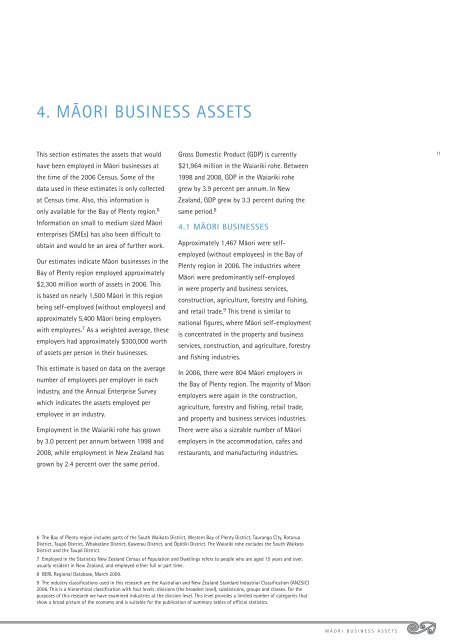Full Document: PDF 949KB - Te Puni Kokiri
Full Document: PDF 949KB - Te Puni Kokiri
Full Document: PDF 949KB - Te Puni Kokiri
You also want an ePaper? Increase the reach of your titles
YUMPU automatically turns print PDFs into web optimized ePapers that Google loves.
4. MÄORI BUSINESS ASSETS<br />
This section estimates the assets that would<br />
have been employed in Mäori businesses at<br />
the time of the 2006 Census. Some of the<br />
data used in these estimates is only collected<br />
at Census time. Also, this information is<br />
only available for the Bay of Plenty region. 6<br />
Information on small to medium sized Mäori<br />
enterprises (SMEs) has also been difficult to<br />
obtain and would be an area of further work.<br />
Our estimates indicate Mäori businesses in the<br />
Bay of Plenty region employed approximately<br />
$2,300 million worth of assets in 2006. This<br />
is based on nearly 1,500 Mäori in this region<br />
being self-employed (without employees) and<br />
approximately 5,400 Mäori being employers<br />
with employees. 7 As a weighted average, these<br />
employers had approximately $300,000 worth<br />
of assets per person in their businesses.<br />
This estimate is based on data on the average<br />
number of employees per employer in each<br />
industry, and the Annual Enterprise Survey<br />
which indicates the assets employed per<br />
employee in an industry.<br />
Employment in the Waiariki rohe has grown<br />
by 3.0 percent per annum between 1998 and<br />
2008, while employment in New Zealand has<br />
grown by 2.4 percent over the same period.<br />
Gross Domestic Product (GDP) is currently<br />
$21,964 million in the Waiariki rohe. Between<br />
1998 and 2008, GDP in the Waiariki rohe<br />
grew by 3.9 percent per annum. In New<br />
Zealand, GDP grew by 3.3 percent during the<br />
same period. 8<br />
4.1 MÄORI BUSINESSES<br />
Approximately 1,467 Mäori were selfemployed<br />
(without employees) in the Bay of<br />
Plenty region in 2006. The industries where<br />
Mäori were predominantly self-employed<br />
in were property and business services,<br />
construction, agriculture, forestry and fishing,<br />
and retail trade. 9 This trend is similar to<br />
national figures, where Mäori self-employment<br />
is concentrated in the property and business<br />
services, construction, and agriculture, forestry<br />
and fishing industries.<br />
In 2006, there were 804 Mäori employers in<br />
the Bay of Plenty region. The majority of Mäori<br />
employers were again in the construction,<br />
agriculture, forestry and fishing, retail trade,<br />
and property and business services industries.<br />
There were also a sizeable number of Mäori<br />
employers in the accommodation, cafes and<br />
restaurants, and manufacturing industries.<br />
11<br />
6 The Bay of Plenty region includes parts of the South Waikato District, Western Bay of Plenty District, Tauranga City, Rotorua<br />
District, Taupö District, Whakatäne District, Kawerau District, and Öpötiki District. The Waiariki rohe excludes the South Waikato<br />
District and the Taupö District.<br />
7 Employed in the Statistics New Zealand Census of Population and Dwellings refers to people who are aged 15 years and over,<br />
usually resident in New Zealand, and employed either full or part time.<br />
8 BERL Regional Database, March 2009.<br />
9 The industry classifications used in this research are the Australian and New Zealand Standard Industrial Classification (ANZSIC)<br />
2006. This is a hierarchical classification with four levels: divisions (the broadest level), subdivisions, groups and classes. For the<br />
purposes of this research we have examined industries at the division level. This level provides a limited number of categories that<br />
show a broad picture of the economy and is suitable for the publication of summary tables of official statistics.<br />
MÄORI BUSINESS ASSETS

















